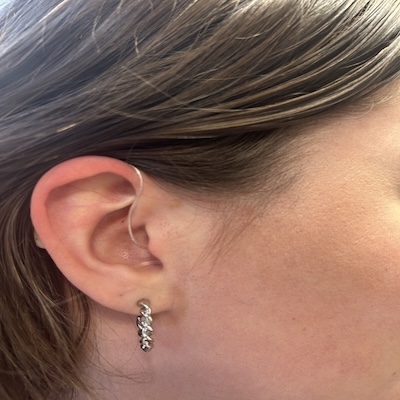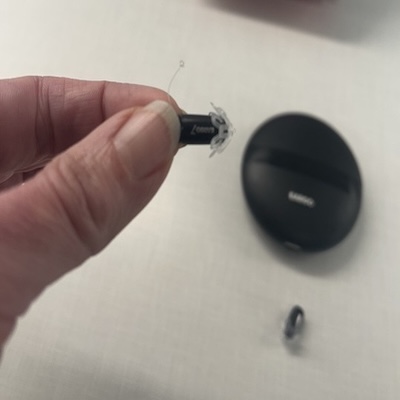Why Signia is the most affordable prescription
Prescription hearing aids are usually more expensive than OTC hearing aids. That’s because they require a prescription, address higher degrees of hearing loss, and are more customizable. Signia, one of the most advanced hearing aid brands in the world, also makes several low-cost prescription devices with advanced technology, making it our choice for “Most Affordable Prescription.”
Signia features
- Bluetooth capabilities: Yes
- How to adjust: Phone app or buttons on hearing aid
- Trial period: Depends on retailer
- Warranty: Depends on retailer
Our experience with Signia
Signia is one of the most well-respected hearing aid brands in the world, and it just so happens to make several affordable prescription models starting around $1,500 per pair.
Not all Signia hearing aids start at this price—the average is about $3,500, according to our research. However, the ability to purchase a prescription hearing aid for less than $2,000 is rare.
And Signia’s affordable hearing aids don’t just have an attractive price—they have some of the strongest technology of any device on this list.
The completely-in-canal Signia Silk X starts at $1,540 and comes in seven different performance levels (common for prescription hearing aids) based on your level of hearing loss.
Another affordable model, the Styletto, is a slim receiver-in-canal (RIC) model that can sell for as little as $1,500. The Styletto has an innovative charging case that doesn’t need to be plugged in—you can just place it on a wireless charging pad.
All Signia models with advanced sound processing technology like Signia Xperience, which processes sound better while you’re moving and uses AI to automatically update sound settings based on your environment. For example, if you’re walking from a quiet to a loud room, Signia hearing aids will update settings automatically to block out background noise and zero in on your conversation partner.
When it comes to a quality prescription hearing aid at low price, we think Signia offers the best option. You can learn more in our Signia hearing aid review.
Why trust Aging in Place
We’ve spent the last four years living and breathing hearing aids. In our research, we’ve:
- Studied 18 brands that make affordable hearing aids
- Surveyed hundreds of hearing aid users
- Tested hearing aids
- Interviewed five hearing instrument specialists, 20 audiologists, and more than 20 real hearing aid users
- Read thousands of verified customer reviews
Read more about how we review hearing aids.
Pros and cons of affordable hearing aids
In a rush to find the best deal, don’t forget to consider the functionality you may be sacrificing for a lower price. What’s more important to you: a low price? Or hearing aids with lots of advanced features? It’s hard to find both. Take a look at the pros and cons of affordable hearing aids below to help understand what’s at stake.
Pros
- Lower price. This one’s simple—the main benefit of affordable hearing aids is that they’re inexpensive. Research shows that people wait, on average, 10 years to get help for hearing loss after realizing they have hearing loss. And one of the biggest reasons people wait is the high cost. Looking for an affordable hearing aid can cut down the time you wait to address your hearing loss.
- Online hearing tests and purchasing. Affordable hearing aids, which are usually OTC hearing aids, often offer simple online hearing tests and the ability to purchase devices without a prescription. That can be more convenient for some people who don’t live near a hearing clinic.
Cons
- Basic technology. Because affordable hearing aids have lower prices, they also tend to have more basic technology. You likely won’t find an affordable hearing aid with tinnitus masking or AI-powered sound processing, for example.
- No in-person support. With the exception of Signia, which is a prescription brand, most affordable hearing aids will not offer in-person support. Instead, you’ll need to work with their customer service team or schedule a remote adjustment appointment if you need help.
How much do hearing aids cost?
Hearing aids cost, on average, $189–$7,000 per pair based on our research, but this figure can change based on style, technology level, and features.
OTC hearing aids are usually more affordable than prescription hearing aids, but be sure you’re getting the support you need.
Why are hearing aids so expensive?
A variety of factors influence the price you’ll pay for hearing aids. For example, audiologists usually charge more for in-person support than specialists who help you with your hearing aids online or over the phone.
This is because in-person, brick-and-mortar clinics have more overhead costs compared to online companies, such as rent, maintenance, and staffing (audiologists also have more specialized medical training).
Does Medicare or insurance cover hearing aids?
Medicare doesn’t cover hearing aids or hearing aid exams. Medicare Part B may cover hearing exams if your doctor orders one to see if you need treatment for something like vertigo. But it won’t cover your general hearing exam if you just need it to get hearing aids.
Your private insurance provider may cover hearing aids or hearing exams, but you should check with your insurer to make sure.
How to save on hearing aid costs
Even though most hearing aids are expensive, there are ways to cut costs. Take a look at these tips for saving money on hearing aids:
- Use an HSA or FSA. You can use HSA and FSA funds to pay for hearing aids.
- Use financing options. Most hearing aid companies will offer financing options, but pay attention to the interest rate—some can be as high as 30%.
- Shop sales. Hearing aid companies offer sales just like other businesses. Look for discounts during regular shopping seasons, like the holidays or end of summer.
- Ask about discounts. Some hearing aid companies offer discounts for people in the armed forces, teachers, healthcare workers, and older adults. Ask the company about any discounts they offer.
Financial assistance for hearing aids
Some non-profit and advocacy organizations are dedicated to getting hearing aids in the hands of people who need them.
Use this partial list to find an organization that can help you afford hearing aids:





